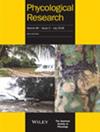Development of DNA markers that distinguish male and female haploid germlings of the brown alga, Cladosiphon okamuranus
IF 1
4区 生物学
Q2 MARINE & FRESHWATER BIOLOGY
引用次数: 1
Abstract
Okinawa mozuku, Cladosiphon okamuranus, is one of many edible brown algae, yielding 22 Kton annually and contributing ¥5 billion to the Japanese economy. The life cycle of C. okamuranus is complicated, since the alga has self‐cloning life cycles in both haploid (N, male and female) and diploid (2N) conditions, but only diploid “seeds” (germlings) become edible sporophytes. Because haploid and diploid germlings are morphologically indistinguishable, haploid germlings are often mistakenly combined with diploid germlings for cultivation, which results in less efficient harvesting of mozuku. Sexual identification of haploid germlings is essential to develop better diploid strains by crossbreeding. With this aim, we performed RNA‐seq analysis of haploid germlings of C. okamuranus. Using its decoded diploid genome and transcriptomic information, we identified 269 genes that are expressed specifically in male or female haploids. BLAST analysis with Ectocarpus siliculosus gene models revealed that nine of 269 genes were putative sex determination‐related genes of C. okamuranus. A unique set of polymerase chain reaction primers for these nine genes was designed, and DNA amplification using primers enabled us to distinguish male and female haploid and diploid germlings. This tool will enable mozuku farmers to select diploid germlings free of haploid germlings. Using this DNA marker technique, the amount of mozuku cultivated in Okinawa is expected to increase.区分褐藻雌雄单倍体胚的DNA标记的建立
冲绳县的绿藻,也就是kadosiphon okamuranus,是众多可食用的褐藻中的一种,每年产量为22千吨,为日本经济贡献50亿日元。C. okamuranus的生命周期是复杂的,因为藻类在单倍体(N,雄性和雌性)和二倍体(2N)条件下都有自我克隆的生命周期,但只有二倍体的“种子”(胚芽)才能成为可食用的孢子体。由于单倍体和二倍体在形态上难以区分,单倍体和二倍体在栽培中经常被错误地结合在一起,这导致了鱼的收获效率降低。单倍体胚性鉴定是杂种培育优良二倍体品系的基础。为了达到这个目的,我们对C. okamuranus的单倍体胚进行了RNA‐seq分析。利用其解码的二倍体基因组和转录组学信息,我们鉴定出269个在雄性或雌性单倍体中特异性表达的基因。BLAST分析结果显示,269个基因中有9个是与C. okamuranus性别决定相关的基因。我们为这9个基因设计了一套独特的聚合酶链反应引物,并利用引物进行DNA扩增,使我们能够区分雌雄单倍体和二倍体胚。该工具将使mozuku农民选择二倍体的种子,而不是单倍体的种子。利用这种DNA标记技术,冲绳县种植的刺鱼数量有望增加。
本文章由计算机程序翻译,如有差异,请以英文原文为准。
求助全文
约1分钟内获得全文
求助全文
来源期刊

Phycological Research
生物-海洋与淡水生物学
CiteScore
3.60
自引率
13.30%
发文量
33
审稿时长
>12 weeks
期刊介绍:
Phycological Research is published by the Japanese Society of Phycology and complements the Japanese Journal of Phycology. The Journal publishes international, basic or applied, peer-reviewed research dealing with all aspects of phycology including ecology, taxonomy and phylogeny, evolution, genetics, molecular biology, biochemistry, cell biology, morphology, physiology, new techniques to facilitate the international exchange of results. All articles are peer-reviewed by at least two researchers expert in the filed of the submitted paper. Phycological Research has been credited by the International Association for Plant Taxonomy for the purpose of registration of new non-vascular plant names (including fossils).
 求助内容:
求助内容: 应助结果提醒方式:
应助结果提醒方式:


